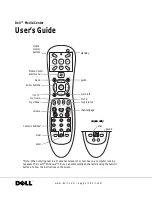
2-1
2. Reference Information
2-1 IC Dsecriptions
2-1-1 AIC1 (AK4393 ; Digital-to-Analog Converter)
Serial
Input
Interface
De-emphasis
Control
De-emphasis
Soft Mute
De-emphasis
Soft Mute
Left Channel
Right Channel
8X
Interpolator
8X
Interpolator
Multi-bit ˘•
Modulator
Multi-bit ˘•
Modulator
Switched
Capacitor Filter
Switched
Capacitor Filter
Control
Register
Double
Speed Select
Soft Mute
Power Down
Serial Data
Bit Clock
Left/Right Clock
Serial
Input Control
Clock Divider
Master Clock
Clock Control
Left Output -
Left
Right Output -
Right
DVSS
DVDD
MCLK
PD
BICK
SDATA
LRCK
SMUTE
DFS
DEM0
DEM1
DIF0
1
2
3
4
5
6
7
8
9
10
11
12
DIF1
13
DIF2
CKS2
CKS1
CKS0
P/S
VCOM
AOUTL+
AOUTL-
AOUTR+
AOUTR-
AVSS
AVDD
VREFH
VREFL
BVSS
14
28
27
26
25
24
23
22
21
20
19
18
17
16
15
No.
Pin Name
I/O
Pin Function and Description
1
DVSS
-
Digital Ground. Digital ground is 0V.
2
DVDD
-
Digital Supply. 3.3V or 5.0V nominal.
3
MCLK
I
Master Clock Input.
4
PD
I
Power-down and Reset.
When low the AK4393 is in Power-down Mode and held in reset.
The AK4393 should always be reset after power-up.
5
BICK
I
Audio Serial Data Clock Input.
A clock input of 64fs or more is recommended.
6
SDATA
I
Serial Data Input.
7
LRCK
I
Left/Right Clock Input. Defines the sampling rate, F
s
.
8
SMUTE
(or CS)
I
Soft Mute Input or Chip Select Input.
If the P/S
pin (pin 25) is high, SMUTE controls the
soft mute function as follows:
- When SMUTE goes high, the soft mute cycle is initiated.
- When SMUTE goes low, the output mute is slowly released.
If the P/S pin is low, SMUTE is the Chip Select Input for the Serial Control Mode. Chip
select is active when SMUTE is low.
9
DFS
I
Double Sampling Speed Input.
When low, this pin defines the Normal Speed Mode, and
128 x F
s
oversampling is implemented. When high, the DFS pin defines the Double Speed
Mode, implemented with 64 x F
s
oversampling. This pin features an internal pull-down.
10
DEM0
(or CCLK)
I
De-emphasis Enable #0 or Control Data Clock Input. If the P/S pin (pin 25) is high,
DEM0 is used to select the De-emphasis Mode according to Table 3. If the P/S pin os low
DEM0 is the clock input for the Serial Control Mode.
11
DEM1
(or CDTI)
I
De-emphasis Enable #1 or Control Data Input.
If the P/S
pin (pin 25) is high, DEM1 is
used to select the De-emphasis Mode according to Table 3. If the P/S pin is low, DEM1 is
the control data input for the Serial Control Mode.
12
DIF0
I
Digital Input Format Select #0.
13
DIF1
I
Digital Input Format Select #1.
14
DIF2
I
Digital Input Format Select #2.
15
BVSS
-
Substrate Ground Pin. Substrate ground is 0V.
16
VREFL
I
Low Level Voltage Reference Input.
Normally connected to analog ground.
17
VREFH
I
High Level Voltage Reference Input.
Normally connected to analog supply.
18
AVDD
-
Analog Supply. Analog supply is 5V nominal.
19
AVSS
-
Analog Ground. Analog ground is 0V.
20
AOUTR-
O
Right Channel Negative Output.
21
AOUTR+
O
Right Channel Positive Output.
22
AOUTL-
O
Left Channel Negative Output.
23
AOUTL+
O
Left Channel Positive Output.
24
VCOM
O
Common Voltage Output. Common voltage output is 2.6V nominal.
25
P/S
I
Parallel/Serial Control Mode Select Input.
If Low, the Serial Control Mode is
implemented. If High, the Parallel Control Mode is selected. This pin has an internal
pull-up.
26
CKS0
I
Master Clock Select #0.
27
CKS1
I
Master Clock Select #1.
28
CKS2
I
Master Clock Select #2.
Summary of Contents for DV-P303U
Page 29: ...Reference Information 2 22 MEMO ...
Page 31: ...Product Specification 3 2 MEMO ...
Page 49: ...5 14 Disassembly and Reaasembly MEMO ...
Page 69: ...Circuit Descriptions 6 20 MEMO ...
Page 79: ...Troubleshooting 7 10 MEMO ...
Page 80: ...8 1 8 Exploded View 8 1 Cabinet Assembly 8 2 Deck Assembly Page 8 2 8 3 ...
Page 82: ...8 3 Exploded Views 8 2 Deck Assembly 107 906 ...
Page 83: ...Exploded Views 8 4 MEMO ...
Page 85: ...9 2 Replacement Parts List MEMO ...
Page 87: ...PCB Diagrams 1 11 1 Main COMPONENT SOLDER SIDE ...
Page 88: ...PCB Diagrams 2 11 2 Jack ...
Page 89: ...PCB Diagrams 3 11 3 Key 11 4 Deck ...
Page 90: ...12 1 12 Wiring Diagram ...
Page 91: ...Wiring Diagram 12 2 MEMO ...
Page 93: ...Schematic Diagrams 13 2 13 1 Power ...
Page 94: ...Schematic Diagrams 13 3 13 2 Main Micom ...
Page 95: ...Schematic Diagrams 13 4 13 3 Servo ...
Page 96: ...Schematic Diagrams 13 5 13 4 Video ...
Page 97: ...Schematic Diagrams 13 6 13 5 Audio ...
Page 98: ...Schematic Diagrams 13 7 13 6 RF ...
Page 99: ...Schematic Diagrams 13 8 13 7 ZiVA ...
Page 100: ...Schematic Diagrams 13 9 13 8 DSP ...
Page 101: ...Schematic Diagrams 13 10 13 9 Front Micom VFD Display ...
Page 102: ...Schematic Diagrams 13 11 13 10 Key ...
Page 103: ...Schematic Diagrams 13 12 13 11 Deck ...
Page 104: ...Schematic Diagrams 13 13 13 12 Remote Control ...
Page 105: ...Schematic Diagrams 13 14 MEMO ...









































